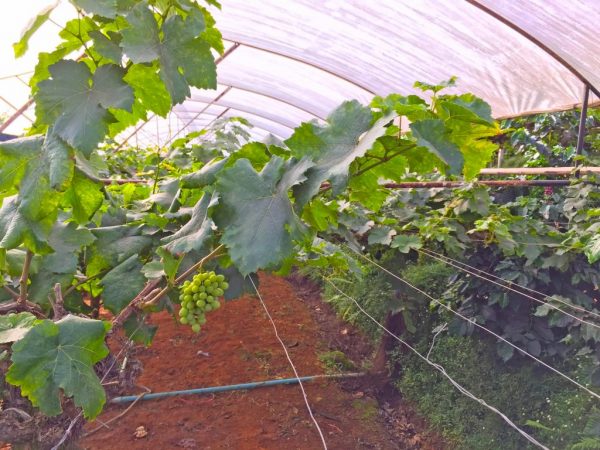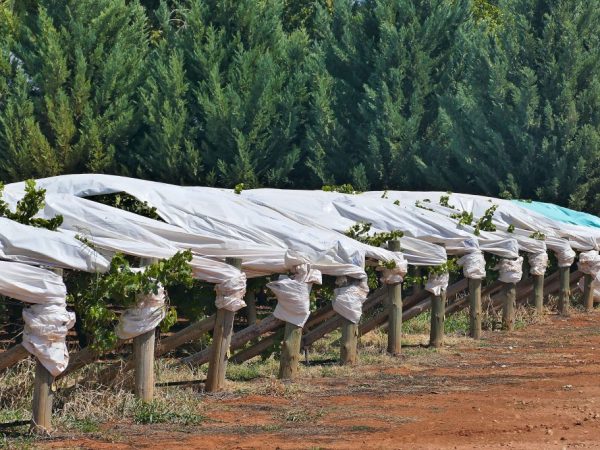Ways to shelter young grapes for the winter
Not all novice growers know what should be the shelter of young grapes for the winter. So that it protects the bush from frost and sudden changes in temperature. Cover young seedlings to protect them in the winter, so that the shoots of the plant do not die.

Ways to shelter young grapes for the winter
When to shelter grapes
Young grape seedlings are covered for the winter in order to ensure the appropriate temperature regime for the bushes. Especially if it is a dry winter, although it is better to play it safe. The hiding procedure does not take much time and effort. It is done by adhering to several rules. The first of which is timing. They are determined depending on the region.
In the northern regions, which actually have low temperatures, it is imperative to cover the vine. The culture can withstand indicators up to -15 ° C. If young seedlings are not covered when the specified value falls, then the plants will lose more than half of their buds. This leads to the death of the entire bush or its harvest.
The root system of the vine is even more vulnerable to frost. The root of the bushes begins to die off at a temperature of -6 ° C. Freezing of the root part adversely affects the life of the entire plant.
In the southern regions, where the temperature in winter does not drop to -14 ° C, there is no need to cover young seedlings. But in such areas, special agrotechnical measures should be adhered to, which are carried out before the onset of winter:
- pruning;
- copper solution treatment;
- fertilization of the soil.
Do not cover seedlings immediately after the first minus temperatures. Small cold snaps will strengthen the vine's immunity. Therefore, the procedure is carried out when the thermometer shows -5 ° C. If you start the procedure in severe frosts, there is a chance that young branches will break.
Grape preparation
Before covering the vine, several procedures are carried out:
- Pruning vines. Increases plant frost resistance. After harvesting the fruits, cut off new shoots.
- Watering is important in October. Due to dry soil, the roots may freeze.
- Fertilizer for protection. The vine is treated with drugs for the prevention of diseases and dung is added to the soil.
- Mulching. Sawdust, straw or cut grass is placed around the bush.
- The branches of the bush are treated with copper solution or lime for disinfection.
Pruning is carried out in September or early November. A well-sharpened instrument is used for the procedure. Cut the branches so that 2-3 eyes are left from the ground level. And to moisten the soil, you will need about 12 buckets for 1 bush. When the liquid evaporates in winter, the steam will warm the roots.
Since in winter the risk of infection of the culture with bacteria, fungi increases and the risk of attack by pests increases, it is treated with fertilizers. For this, the plant is sprayed with one of the drugs:
- Horus;
- "Topaz";
- "Hom";
- "Strobe";
- "Kuprolux";
- "Quadris".
Copper sulfate or Bordeaux liquid is also used. After the procedure, the grape trunk is treated with slaked lime to protect it from rodents.Carrying out all the stages, they begin to shelter a young plant.
Ways to hide grapes

There are several ways to cover plants.
There are several types of shelter, but it is important to maintain air circulation. You can cover the plant by placing it horizontally from the ground. Only frost-resistant varieties are left upright.
The main ways of hiding are:
- semi-shelter;
- hilling;
- full cover.
Hilling is a procedure that provides for an embankment around the crop with a layer of 20 cm. This method is used in the first years of cultivation, since it only protects the root system and lower shoots. Wood sawdust, earth with sand, dried grass are used as material for the embankment. With this method, it is necessary to update the embankment, because under the influence of atmospheric precipitation, the soil settles.
The semi-shelter protects only the part of the plant close to the ground, which is covered with a cloth or film. The method is used for bushes that are located in an upright position and cannot be put. It is only half effective, because part of the vine continues to freeze. Therefore, it is also used only for seedlings and new plants.
Full cover
Full cover is the most popular and effective method. To conduct it, they adhere to several rules:
- Carried out when all the leaves have fallen from the grapes.
- Cut off unnecessary old branches and new shoots.
- They dig a hole about 15 cm near the plant and treat it with copper sulfate.
- Tie the branches and lean to the ground, placing the plant in the hole.
- Cover the culture with old clothes or film, pouring earth on top or placing heavy objects.
To prevent the kidneys from getting blocked, they cannot be pressed against the film; it is better to make small openings between the ground and the tissue. If there is a warming in winter, the shelter is removed for a couple of minutes to supply fresh air. In addition to the film, bags, slate, wooden boxes, plastic containers, roofing felt are also used.
A small greenhouse is also suitable for shelter. It is used so as not to bend the branches to the ground. For this, polycarbonate shields are put on a special structure in the form of a frame. They are placed above the plant, driving the columns into the ground.
Conclusion
When choosing how to cover grapes, one should also take into account the absence of disease and damage by rodents. If the culture is weakened, then no procedures will save it from frost. First, treatment is carried out in the form of treatment with drugs or organic matter. In regions with a harsh climate, not ordinary shelters made of fabric or film are installed, but whole boxes or houses made of spruce branches, straw or dry leaves.


